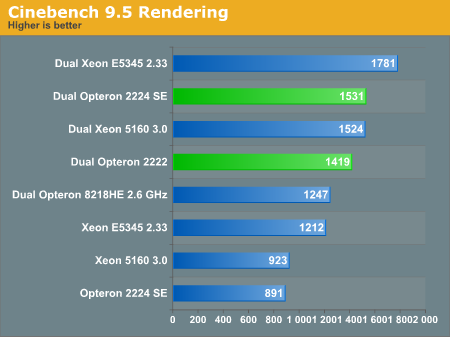Render Servers
To get a better idea on how the different server platforms compare, we did some rendering too. Most of our tests (MySQL, DB2, and SPECjbb2005) are very integer intensive; render tests are floating point intensive. We start with a simple Cinebench 9.5 benchmark (on Windows 2003 32-bit), which is based on Maxon's Cinema 4D rendering engine.

Cinebench runs almost perfectly within the caches of all CPUs. The Opteron 2224 does pretty well thanks to its strong x87 FPU. As we have noted before, the Opteron scales slightly better than its Intel Competitor. This gets even clearer when you look at the performance of one core. One Opteron 3.2GHz core scores 472 and gets 3.24 times faster when you quadruple the number of cores. One Intel core at 3GHz scores 499 and gets 3.05 times faster with 4 cores. We admit we are nitpicking, but it is interesting nevertheless.
3DS Max 9
Cinebench is popular because it is an easy benchmark, 3DS Max is a very popular application. We tested with 3DS Max version 9, which has been improved to work better with multi-core systems. We used the "architecture" scene, which has been a favorite benchmarking scene for years. All tests were done with 3ds max's default scanline renderer, SSE enabled, and we rendered at HD 720p (1280x720) resolution. We measured the time it takes to render 10 frames from 20 to 29. All results are reported in seconds, lower being better.


As this test has been our standard test for a while, we added a few results from previous tests. As you increase the resolution, multi-core scaling gets better. The reason is that there's a certain amount of overhead required to split a scene into multiple parts. At lower resolutions, the splitting process ends up taking a significant amount of time, so the extra cores are not fully able to stretch their legs.
To get a better idea on how the different server platforms compare, we did some rendering too. Most of our tests (MySQL, DB2, and SPECjbb2005) are very integer intensive; render tests are floating point intensive. We start with a simple Cinebench 9.5 benchmark (on Windows 2003 32-bit), which is based on Maxon's Cinema 4D rendering engine.

Cinebench runs almost perfectly within the caches of all CPUs. The Opteron 2224 does pretty well thanks to its strong x87 FPU. As we have noted before, the Opteron scales slightly better than its Intel Competitor. This gets even clearer when you look at the performance of one core. One Opteron 3.2GHz core scores 472 and gets 3.24 times faster when you quadruple the number of cores. One Intel core at 3GHz scores 499 and gets 3.05 times faster with 4 cores. We admit we are nitpicking, but it is interesting nevertheless.
3DS Max 9
Cinebench is popular because it is an easy benchmark, 3DS Max is a very popular application. We tested with 3DS Max version 9, which has been improved to work better with multi-core systems. We used the "architecture" scene, which has been a favorite benchmarking scene for years. All tests were done with 3ds max's default scanline renderer, SSE enabled, and we rendered at HD 720p (1280x720) resolution. We measured the time it takes to render 10 frames from 20 to 29. All results are reported in seconds, lower being better.


As this test has been our standard test for a while, we added a few results from previous tests. As you increase the resolution, multi-core scaling gets better. The reason is that there's a certain amount of overhead required to split a scene into multiple parts. At lower resolutions, the splitting process ends up taking a significant amount of time, so the extra cores are not fully able to stretch their legs.










30 Comments
View All Comments
Spoelie - Monday, August 6, 2007 - link
Thanks for the clarification, I was under the impression the only real states were idle (1ghz) and full tilt (3.2ghz). Never seen any other states but all I ever use are the desktop chips, I wasn't aware CnQ could be more dynamic than that.yuchai - Monday, August 6, 2007 - link
I believe all A64 chips including the desktop ones have the different power states. For example my X2 4200+ has 4 states. 1.0, 1.8, 2.0 and 2.2 Ghz.ButterFlyEffect78 - Monday, August 6, 2007 - link
Are they talking about the barcelona?If not, then this is old news.
I'm sure everyone by now knows that intels new cpu's are better then the current AMD opterons.
KingofFah - Monday, August 6, 2007 - link
It really isn't. The were demonstrating the new 3.2ghz opteron. Also, this was a dual socket setup, and anand said, and everyone who monitors the server world knows, that the opterons come out ahead overall in the 4S environment.The more sockets, the more performance advantage opterons have on intel in the server space. This is well known. The purpose of this was to show it in the dual socket environment.
duploxxx - Monday, August 6, 2007 - link
confused, no it is the stupidity of people like you that think that all Intel offerings are better then the ones for AMD.@anand, you're conclusion of the database world that the quadcore still rules..... where are the benchmarks?
now it is nice to see all these benches next to each other, when are you going to combine benches, no longer servers are used for one application, they are more combined these days with more apps. Maybe its time you also have a look at vmware esx etc.... will probably give you a different look at the offerings of AMD these days.
clairvoyant129 - Monday, August 6, 2007 - link
You don't have to get hostile because he does have a point. In the desktop market, Intel is clearly better unless we're talking about low end. Server market, it's still a toss up but Intel still has a lead.yyrkoon - Monday, August 6, 2007 - link
Um, you guys obviously have not been paying much attention have you ?1) AMD CPUs=cheaper
2) AMD CPUs of comparrible speed perform nearly as good if not as good or better than their Intel counterparts. ie: I think you better check the last benchmarks anandtech post 'homie', because I saw a lot of AMD on top of the game benches. (6000+ vs e6600).
3) Yes, a C2D *may* overclock better, and if it is you intention to overclock, it makes perfect sense to buy one, just be prepared to pay more for the CPU.
4) Up until recently, or possibly still happening into the near future, AMD system boards availible often offered more features for less cost. It does seem however with the P35 Chipset, vendors are starting to come around.
5) last, but not least, THIS article IS NOT about desktop hardware now IS IT ?! why bring some stupid lame ass coment into some place that it does not even fit ? GOd, and I thought I needed a new life . . .
Final Hamlet - Monday, August 6, 2007 - link
It is these "but"s, that make the difference.If they exist, you can't state "all Intel CPUs" anymore, because there are exceptions.
ButterFlyEffect78 - Monday, August 6, 2007 - link
I'm sorry everybody.English is my 2nd language so I sometimes can't always express what I want to say.
What i meant to say is that Intel's new line of cpu's based on Core 2 duo tech. are better-(more advanced) then those based on K8 technology. If this is not true then there should not be a reason to introduce the K10 later this year to counterattack core 2 duo/quad.
But again, I could be wrong.
Calin - Monday, August 6, 2007 - link
Core2Duo technology from Intel is better overall than the K8 technology from AMD - this includes basic architecture, current improvements on the initial architecture (K8 is older and has more of those small improvements), and process/production technology.However, Intel lagged in introduction of Core2 based server processors, and even now their FBDIMM technology is slower and hotter (power hungry) than AMD's Opteron/DDR. Until this changes, AMD still has a market in servers, albeit not as good as before the Core2Duo Xeon processors.